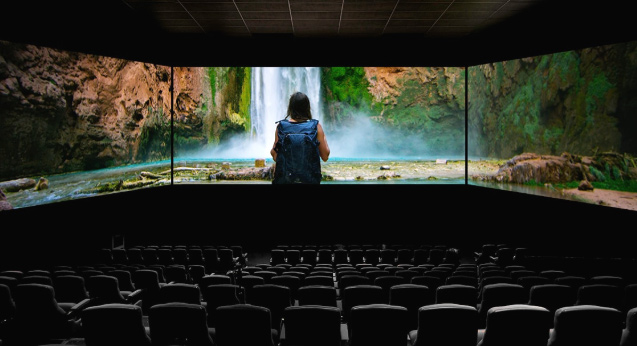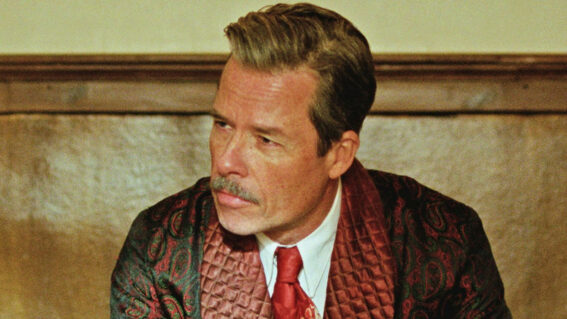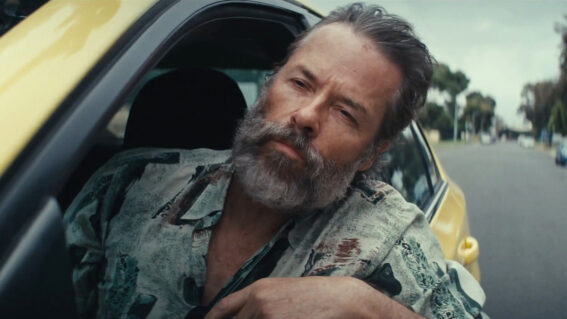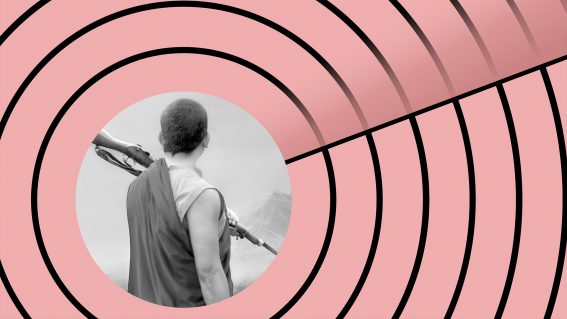I watched a dodgy Nicolas Cage movie in virtual reality and this is what happened. Spoiler alert: it got weird

It is highly likely, if you are reading this, that you have watched a Nicolas Cage movie before. Perhaps you have seen several. In which case you might have experienced the dramatically credible Nicolas Cage (Leaving Las Vegas), the not at all dramatically credible Nicolas Cage (Captain Corelli’s Mandolin), the explosively idiotic Nicolas Cage (Face/Off), the arty experimental Nicolas Cage (Wild at Heart), the action hero Nicolas Cage (National Treasure) or even the leader-of-a-biblical-Rapture Nicolas Cage (Left Behind).
There is, indeed, a Nicolas Cage for all occasions, which sounds like a terrifying idea for an Advent calendar. I am willing to bet, however, you have not seen Nicolas Cage as I now have: on three gigantic, building-sized wide screens, stacked next to each other, simultaneously projecting scenes from his latest B movie. The cinema I experienced this bizarre spectacle in wasn’t the local multiplex. It was an empty auditorium, with no seats or doors or people or popcorn, available only in virtual reality.
My journey into virtual, thrice-rendered Cage began when I saw an advertisement for the actor’s new film. It declared that the awkwardly titled The Humanity Bureau (yes that is actually its title) was available to watch, in virtual reality, in two different formats. The first was standard 2D widescreen. The second was the ’Barco Escape’ three screen format.
Who (or what) was this Barco? Where would I be escaping to? I had no idea what any of this meant – so naturally I decided I would watch this movie in Barco, or I would not watch this movie at all. According to the official website, it is “an unmatched immersive viewing experience” featuring not one but three huge wide screens. Barco Escape was described by Jerry Bruckheimer as nothing less “the future of the cinema experience.”
As it turns out, the legendary Hollywood producer was referring to the very immediate future, which is now the past. Debuting in specially modified cinemas in America in late 2014, with a special cut of The Maze Runner, the format featured modified versions of a few big titles including Star Trek Beyond. It was not to be; the company dissolved in February this year. The Humanity Bureau was one of the first (and last) productions to be shot “natively” in the Barco format.

Set in a desperate, dystopian, climate change-ravaged future, The Humanity Bureau presents a gloomy version of America, where even basic resources such as water have become precious scarcities. Everything went to the dogs quickly; the year is 2030. Cage plays Noah Cross, an agent for the titular government department whose job is to evaluate the productivity of citizens. Those determined to be a burden to the system are sent to a mysterious place called ‘New Eden’, from which nobody returns.
Director Rob W. King has neither the budget nor the ingenuity to present a plausible vision of the future, and Dave Schultz’s screenplay is a strange combination of chaotic and languid. The film was, however, very much in the special Barco format. If you’ve ever seen a special ‘IMAX shot’ feature film at an IMAX cinema, you know roughly what to expect. The normal single screen periodically expands (to three) and contracts (back to one), depending on whether the scene in question was recorded in the special format.
The film’s opening wide shot is really, really wide: a musty brown skyline spread across three screens. The director segues to aerial images of a car travelling through outback Nevada, still in three screens. When we are whisked inside the vehicle the film shrinks to a single image, showing Nicolas Cage behind the wheel. When it returns to exterior shots it goes back to three screens. Back to Cage, back to one. This happens several times in a row. I began to think every shot in the film other than those depicting Cage would revert to Barco, as if the actor had contractually prohibited the one reason I decided to watch this movie.
The Barco Escape format also gives the impression of taking audiences further away from naturalism. In that sense the format is perfect for Cage, and Cage is perfect for the format.
But soon enough we get to watch crazy ol’ Nic Cage in full three screen glory. Sometimes he walks from the very left of the left screen to the very right of the right, requiring the viewer to turn their heads. Occasionally the three screens are divided into separate images, but not necessarily three separate images. The screen on the left, for example, may show one image, the two on the right combining to show another. It’s an interesting experience, though this film doesn’t put the technology to use in any particularly memorable ways.
I imagine that sitting through The Humanity Bureau, Barco-style, is like watching a faulty video art installation project: edgy and visceral in ways not entirely intended. Even the gimmicky thrill of this new format does not, however, manage to wake Nicolas Cage up. The actor delivers a truly somnambulant performance, as if he wolfed down a packet of valium prior to the shoot. There are times when he handles normal lines of dialogue in unusual ways, infusing them with an unnecessary erratic quality. At one point Cage’s line is simply “What is the truth?” But he delivers the first two words very slowly, and the second two very fast. So it sounds like: “What…..is…..THE-TRUTH?”
During a reddit ‘Ask Me Anything’ chat in 2013, fellow thespian Ethan Hawke discussed his Nicolas Cage man crush, saying: “He’s the only actor since Marlon Brando that’s actually done anything new with the art of acting. He’s successfully taken us away from an obsession with naturalism into a kind of presentation style of acting that I imagine was popular with the old troubadours.”
The Barco Escape format also gives the impression of taking audiences further away from naturalism. In that sense the format is perfect for Cage, and Cage is perfect for the format. I doubt even the oldest and greatest troubadours boast a body of work so varied and eclectic as his. And surely none of them have had their performances displayed on three gigantic screens in virtual reality, in the now defunct – but long may it live in the virtual realm – Barco Escape format.

















